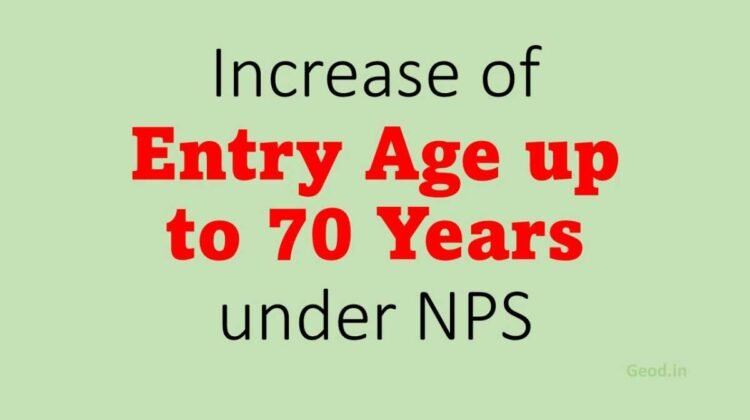
PFRDA Circular – Increase of Entry Age up to 70 Years under National Pension Scheme (NPS)
PENSION FUND REGULATORY AND DEVELOPMENT AUTHORITY
B-14/A Chhatrapati Shivaji Bhawan
Qutab Institutional Area,
Katwaria Sarai, New Delhi-110016
CIRCULAR
Circular no.: PFRDA/2021/36/SUP-CRA/14
August 26, 2021
To,
All Central Record Keeping Agencies (CRAs)
&
other NPS stakeholders for information
Subject: Increase of Entry Age up to 70 Years under NPS
In response to the large number of requests received from the existing Subscribers to remain invested under NPS beyond 60 years or beyond their superannuation, and the desire from citizens above 65 years to open NPS, it has been decided to increase the entry age of NPS in the interest of Subscribers and benefit them with the opportunity of creating a long term sustainable pension wealth. The existing age of entry which is 18-65 years has been revised to 18-70 years.
Accordingly, PFRDA has revised the guidelines on entry and exit. Any Indian Citizen, resident or non-resident and Overseas Citizen of India (OCI) between the age of 65-70 years can join NPS and continue or defer their NPS Account up to the age of 75 years. Those Subscribers who have closed their NPS Accounts are permitted to open a new NPS Account as per increased age eligibility norms. The unique features and benefits of increased age of entry are as mentioned below,
A. Choice of Pension Fund (PF) and Asset Allocation:
The Subscriber, joining NPS beyond the age of 65 years, can exercise the choice of PF and Asset Allocation with the maximum equity exposure of 15% and 50% under Auto and Active Choice respectively. The PF can be changed once per year whereas the asset allocation can be changed twice.
B. Exit and withdrawals:
The exit conditions for subscribers joining NPS beyond the age of 65 years will be as under:
a. Normal Exit shall be after 3 years. The subscriber will be required to utilize at least 40% of the corpus for purchase of annuity and the remaining amount can be withdrawn as lump sum. However, if the corpus is equal to or less than ₹5.00 lakh, the Subscriber may opt to withdraw the entire accumulated pension wealth in lump sum.
b. Exit before completion of 3 years shall be treated as Premature Exit. Under pre-mature exit, the Subscriber is required to utilize at least 80% of the corpus for purchase of annuity and the remaining can be withdrawn in lump sum. However, if the corpus is equal to or less than ₹2.5 lakh, the subscriber may opt to withdraw the entire accumulated pension wealth in lump sum.
c. In case of unfortunate death of the subscriber, the entire corpus will be paid to the nominee of the subscriber as lump sum.
The Investment and Exit features are provided at the Annexure for ready reference.
C. NPS Tier II Account:
The Subscribers are also eligible to open Tier II Account for investing their disposable income to optimize their returns which unlike Tier-I account can be withdrawn at any time.
CRAs are advised to roll out the new feature for the benefit of Subscribers in a time bound manner. Also, CRAs need to disseminate the information and create awareness through SMS, Educational videos, FAQ, Email communication and creative contents as deemed fit.
For any assistance, Mr. A. Ramesh Kumar (ramesh[dot]kumar[at]pfrda[dot]org[dot]in) or the undersigned can be contacted.
This circular is issued under Section 14 of PFRDA Act 2013 and is available at PFRDA’s website (www.pfrda.org.in) under the Regulatory framework in “Circular” section.
Sd/-
(K. Mohan Gandhi)
Chief General Manager
I. Investment Option for Subscribers
1. Auto Choice: The maximum exposure under equity asset class is 15%.
| Sl.No. | Auto Choice | Asset Class in Percent | ||
|---|---|---|---|---|
| Equity (E) | Corporate Bond (C) | Government Bond (G) | ||
| 1 | Aggressive Life Cycle Fund (LC 75) | 15 | 10 | 75 |
| 2 | Moderate Life Cycle Fund (LC 50) | 10 | 10 | 80 |
| 3 | Conservative Life Cycle Fund (LC 25) | 5 | 5 | 90 |
2. Active Choice: The cap on equity exposure is 50% and rest of the asset classes as per choice of the subscriber.
| Auto Choice | Cap on Asset Class | |||
|---|---|---|---|---|
| Equity (E) | Corporate Bond (C) | Government Securities (G) | Alternate Investment (A)* | |
| Percentage of Allocation | 50% | 100% | 100% | 5% |
| (*Alternate Investment as asset class not provided under Tier II) | ||||
II. Exit Option for Subscribers
| Type of Exit | Lump sum withdrawal (Maximum) | Annuity (Minimum) |
|---|---|---|
| Normal Exit (if Corpus > 5 Lakh) | 60% | 40% |
| Pre-Mature Exit (if Corpus > 2.5 Lakh) | 20% | 80% |
| Unfortunate Death of the Subscriber | Entire corpus payable to the nominee as lump sum | |

